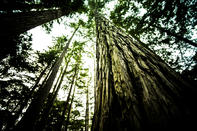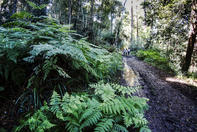Transitional Zone
Grootvadersbosch Nature Reserve in the Overberg, Western Cape, is set in a mountainous region that falls within a transitional zone between winter-specific and year-round rainfall, so less precipitation can be expected from May to July and from December to January.

Berg winds are prevalent from May to July. Typical forest tree species include stinkwood, yellowwood, red alder and ironwood. From 1896 to 1913 exotic trees were introduced to cover areas which had been deforested. These species include camphor, bluegum, Californian redwood, Australian blackwood and oak. These areas are now being reclaimed for indigenous forests.
Outdoor Nirvana

A plethora of trails spiderwebs throughout Grootvadersbosch Nature Reserve and the adjacent conservancy, creating a natural wonder-world sure to transport you straight into a state of outdoor nirvana. The area serves as a transition zone between the mountain fynbos of the Overberg and the more arid ridges overlooking the Little Karoo, and will, therefore, delight you with its diverse range of botanical biomes, including mountain fynbos, remnant forest and rare Renosterveld.
Animals as diverse as Grysbok, Bush pig, Porcupine, Aardwolf, Caracal and Cape leopard inhabit the area, although the latter is pretty elusive and will rarely be seen. Birders, however, will go crazy over plentiful Turacos, nesting Crowned Eagles, Narina Trogon, Secretary birds, a multitude of Blue Cranes and a host of less conspicuous ‘lifers’.
The Grootvadersbosch Conservancy boasts an impressive 49 mammal species – eight of which are on the Red Data List – as well as 16 frog species (including the endemic ghost forest frog), 49 reptile species, eight fish species, eleven butterfly species, an incredible 200+ bird species and 46 species of indigenous mountain fynbos.
Did you Know? The birding here is generally done in a forest environment, and therefore much of your identification needs to be done via sound. A birding app for your cell phone not only allows you to identify the sound, but also makes it possible to ‘call’ the bird in closer for a visual identification. The sleepy Overberg farming community of Heidelberg, situated on the N2 in the shadows of the majestic Langeberg Mountains, serves as your m...
The sleepy Overberg farming community of Heidelberg, situated on the N2 in the shadows of the majestic Langeberg Mountains, serves as your m...